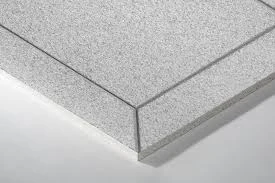- Afrikaans
- Albanian
- Amharic
- Arabic
- Armenian
- Azerbaijani
- Basque
- Belarusian
- Bengali
- Bosnian
- Bulgarian
- Catalan
- Cebuano
- Corsican
- Croatian
- Czech
- Danish
- Dutch
- English
- Esperanto
- Estonian
- French
- German
- Greek
- Hindi
- Indonesian
- irish
- Italian
- Japanese
- Korean
- Lao
- Malay
- Myanmar
- Norwegian
- Norwegian
- Polish
- Portuguese
- Romanian
- Russian
- Serbian
- Spanish
- Swedish
- Thai
- Turkish
- Ukrainian
- Uzbek
- Vietnamese
Dis . 02, 2024 01:18 Back to list
difference between gypsum and pvc ceiling
The Difference Between Gypsum and PVC Ceilings
In the world of interior design and construction, the choice of ceiling materials plays a critical role in aesthetics, functionality, and maintenance. Among the most popular materials are gypsum and PVC (polyvinyl chloride) ceilings. Though both are widely utilized in residential and commercial spaces, they possess distinct differences that can influence a buyer's decision. This article explores the main differences between gypsum and PVC ceilings, examining their composition, durability, installation processes, and maintenance requirements.
Composition and Structure
Gypsum ceilings are primarily made from gypsum plaster, a natural mineral. Gypsum is known for its fire-resistant properties, making it an ideal choice for spaces that require enhanced safety measures, particularly in commercial buildings. Gypsum boards are typically covered with a layer of paper or fiberglass to increase strength and smoothness. This natural composition allows for excellent sound insulation, delivering a quieter indoor environment.
On the other hand, PVC ceilings consist of synthetic plastic materials. PVC is lightweight, durable, and resistant to moisture, which is why it is commonly used in areas prone to humidity, such as bathrooms and kitchens. PVC tiles or panels come in a variety of colors and patterns, offering a versatile choice for homeowners and designers seeking a modern aesthetic. However, due to their synthetic nature, PVC ceilings are less effective at insulating sound compared to gypsum counterparts.
Durability and Resistance
When it comes to durability, gypsum ceilings are robust and highly resistant to impact damage. However, they can be susceptible to moisture if not properly treated or if installed in humid environments without sufficient protection. In cases where gypsum boards absorb moisture, they may sag or encourage mold growth.
Conversely, PVC ceilings exhibit superior moisture resistance, making them ideal for high-humidity areas. They are impervious to water, thus preventing warping and mold development. Moreover, PVC does not degrade over time under normal conditions, ensuring that it maintains its structural integrity and appearance longer than many traditional materials.
Installation Process
difference between gypsum and pvc ceiling

The installation process for both gypsum and PVC ceilings differs significantly. Gypsum boards require a frame (usually metal or wood) to support the panels. The boards must be cut to size, fixed to the framework, and then finished with joint compound to provide a seamless look. This process can be time-consuming and may require skilled labor, particularly when assessing load-bearing aspects and achieving smooth finishes.
On the contrary, the installation of PVC ceilings tends to be simpler and faster. PVC panels can be directly attached to the ceiling beams or installed on a simple framework. Their lightweight nature also reduces the overall labor required for installation. This ease of installation makes PVC an attractive option for DIY enthusiasts or those looking for quick renovations.
Maintenance and Cleaning
Maintenance is another critical factor distinguishing gypsum and PVC ceilings. Gypsum ceilings typically require regular maintenance to ensure their longevity. They need to be painted or repainted periodically, especially in areas susceptible to wear and tear. Additionally, if water damage occurs, repairs can be challenging, often necessitating the replacement of affected panels.
In contrast, PVC ceilings are much easier to maintain. They do not require painting, and regular cleaning with a damp cloth or mild detergent usually suffices to keep them looking fresh. Their resistance to moisture also means that they are less prone to issues like mold and mildew, which can plague traditional ceiling materials.
Cost Considerations
When comparing costs, gypsum ceilings are often more economical upfront in terms of material price. However, the overall expense can increase due to labor costs related to their installation and maintenance. PVC ceilings might have a higher initial purchase price, but their longevity and minimal maintenance requirements can lead to cost savings in the long run.
Conclusion
In summary, the choice between gypsum and PVC ceilings boils down to individual needs and preferences. Gypsum ceilings provide excellent sound insulation, fire resistance, and a classic finish, making them suitable for many interior designs. Alternatively, PVC ceilings offer moisture resistance, easy installation, and minimal maintenance—ideal for modern spaces and busy lifestyles. Ultimately, understanding the differences between these two materials can empower homeowners and builders to make informed decisions that best suit their specific requirements.
-
Transform Interiors with PVC Gypsum Ceiling: A Stylish, Durable, and Moisture-Resistant SolutionNewsMay.19,2025
-
The Smart Interior Upgrade: Discover the Durability and Versatility of Gypsum Ceiling Access Panel SolutionsNewsMay.19,2025
-
The Smart Choice for Interior Design: Discover the Value of PVC Gypsum Ceiling SolutionsNewsMay.19,2025
-
Mineral Fiber Ceiling Tiles: The Smart Blend of Performance and AestheticsNewsMay.19,2025
-
Mineral Fiber Ceiling Tiles: The Superior Choice Over Gypsum for Sound and Fire SafetyNewsMay.19,2025
-
Mineral Fiber Ceiling Tiles: Eco-Friendly Strength and Style for Every CeilingNewsMay.19,2025







